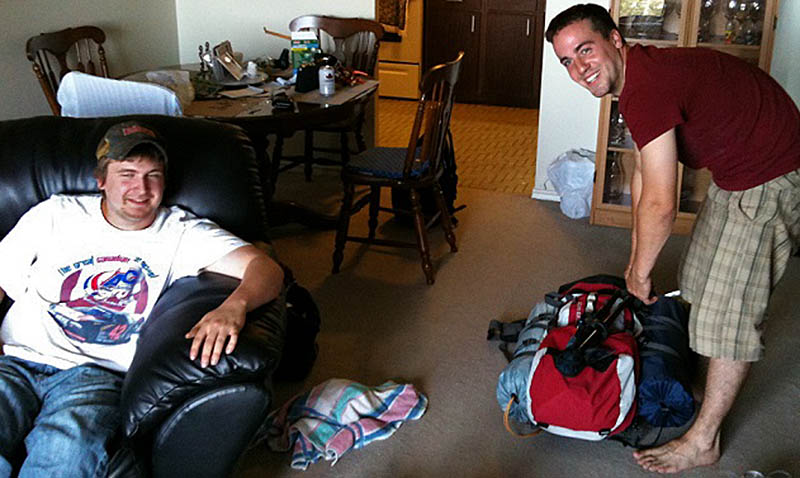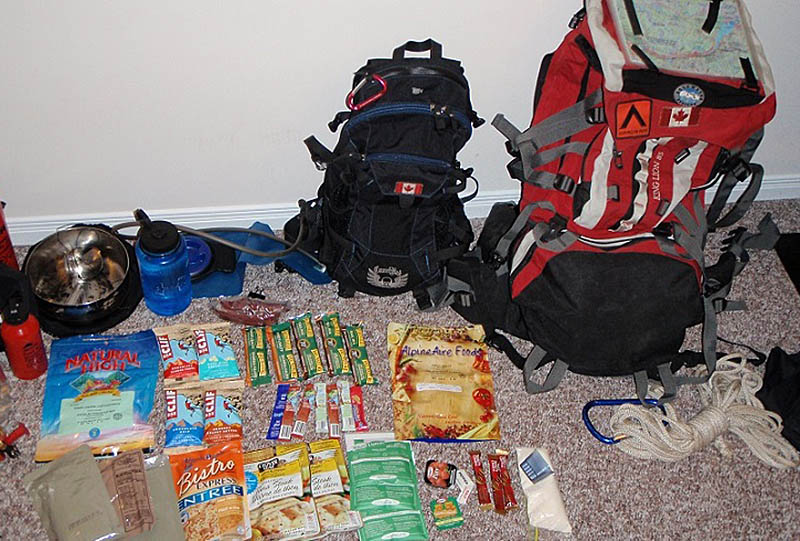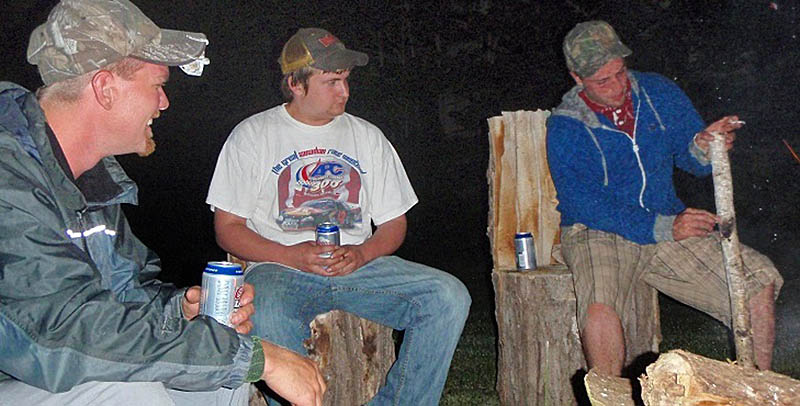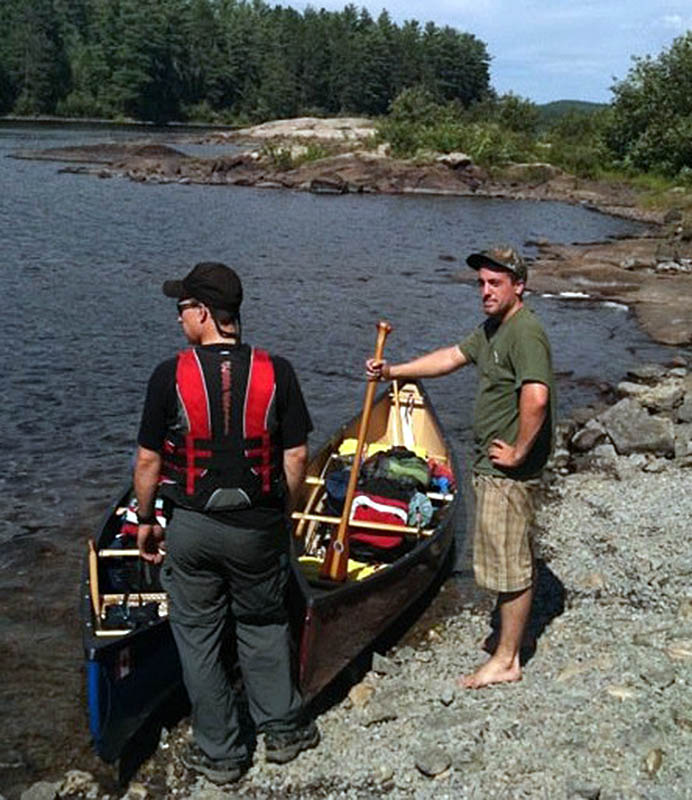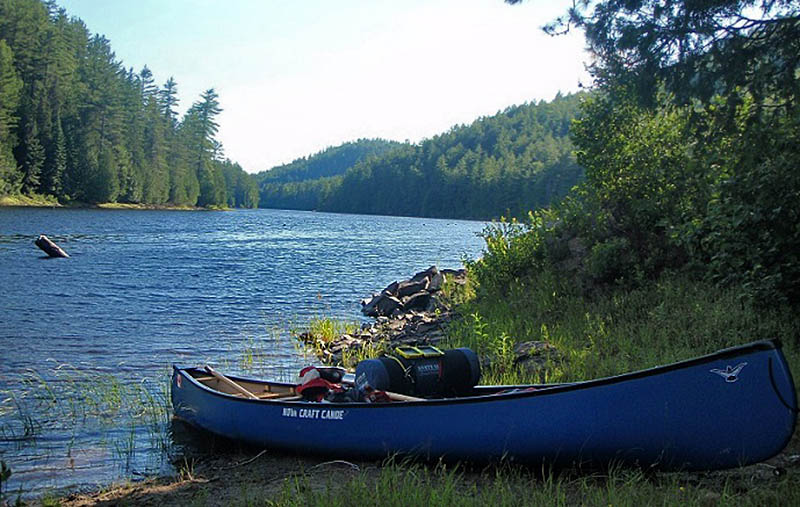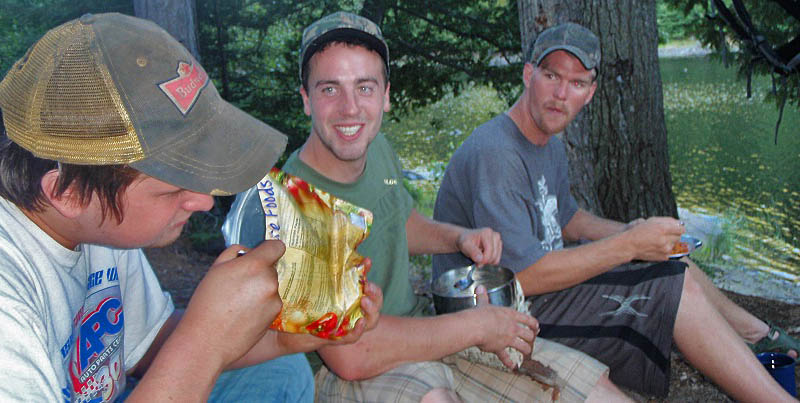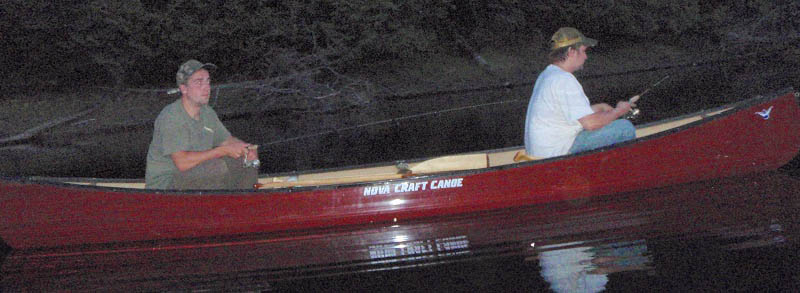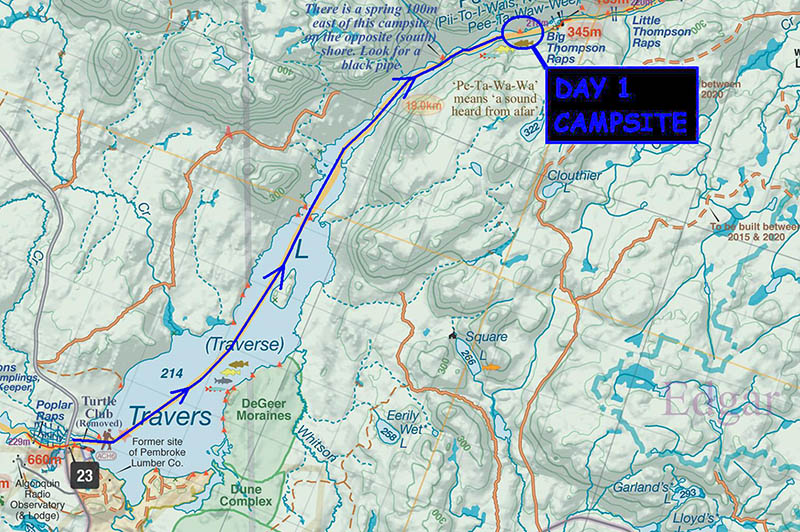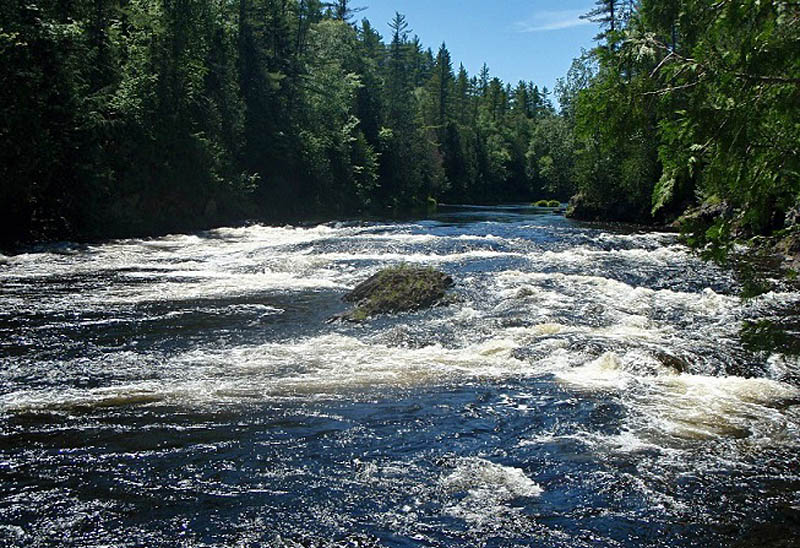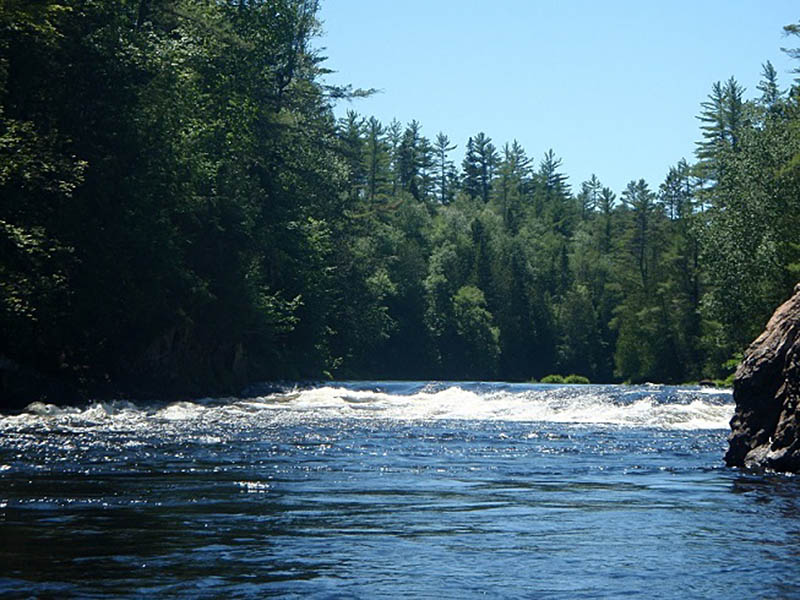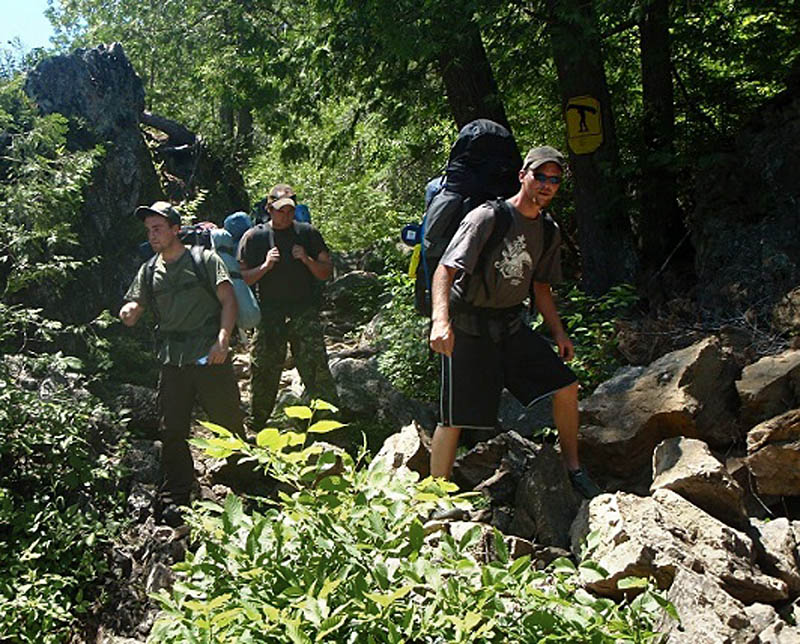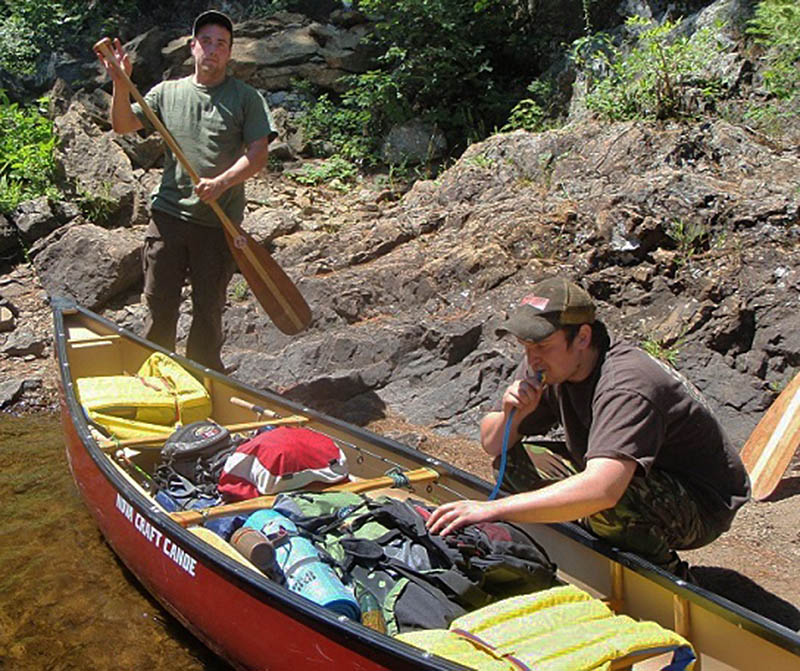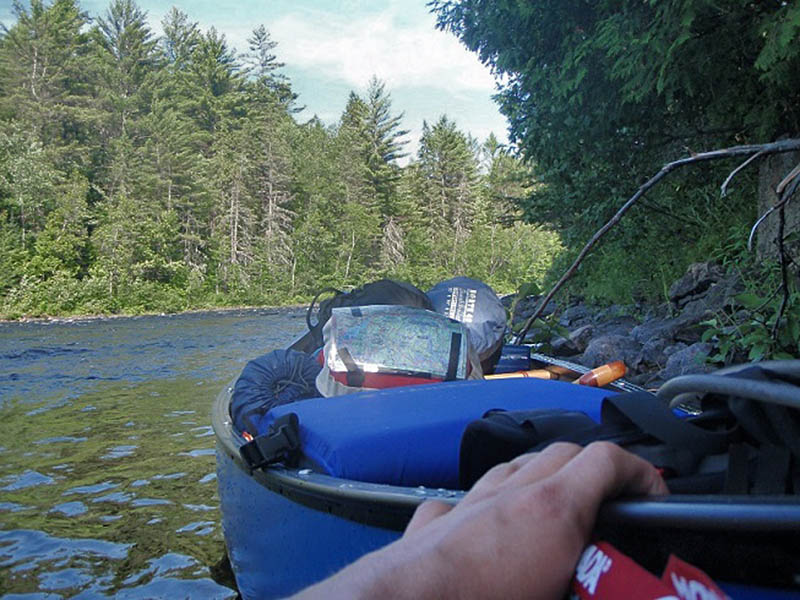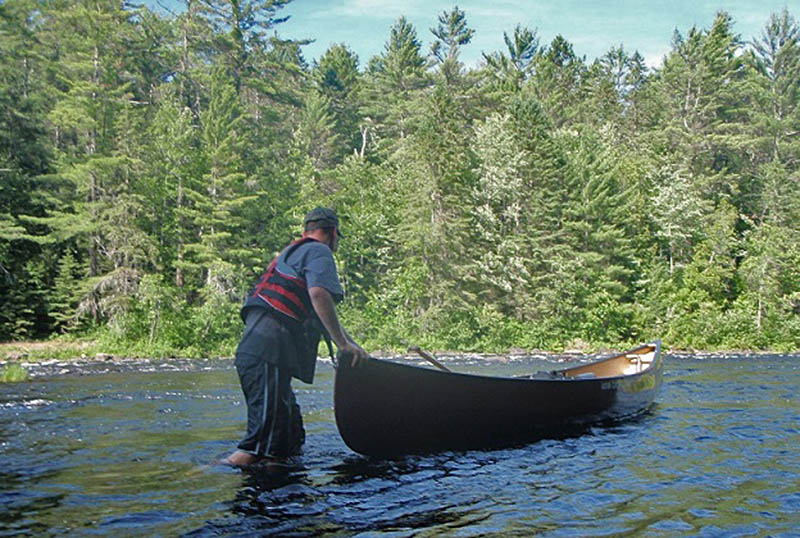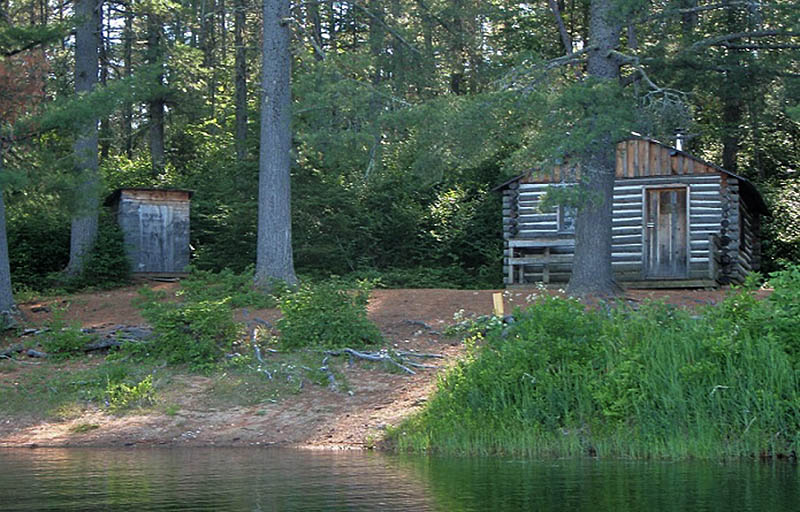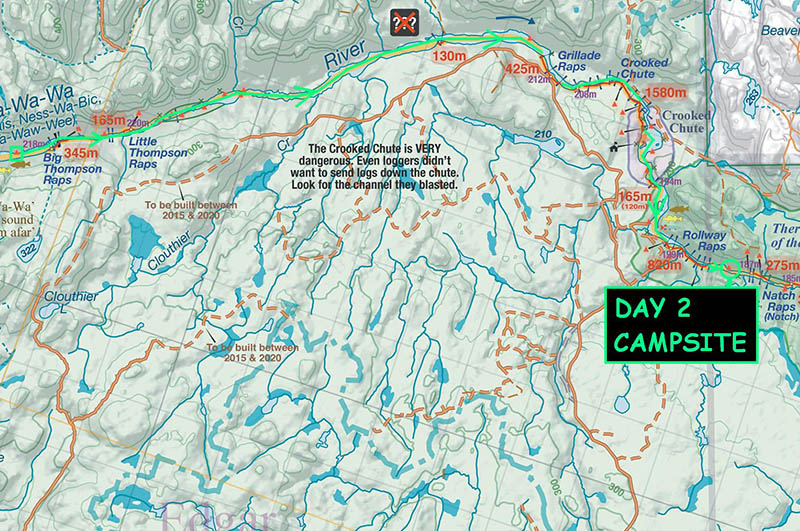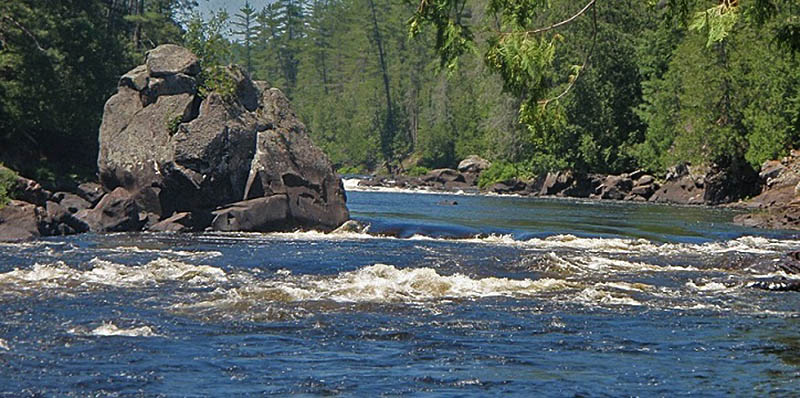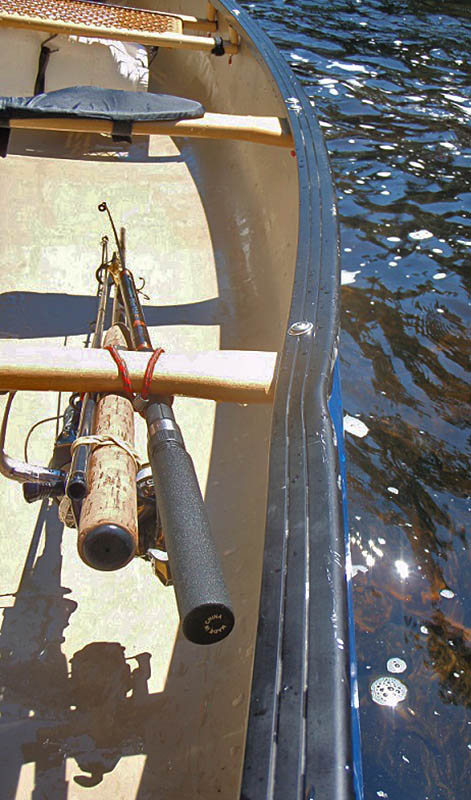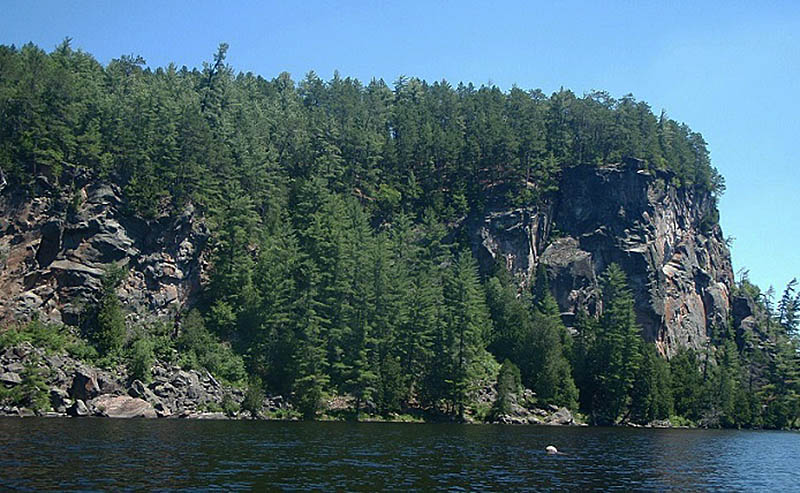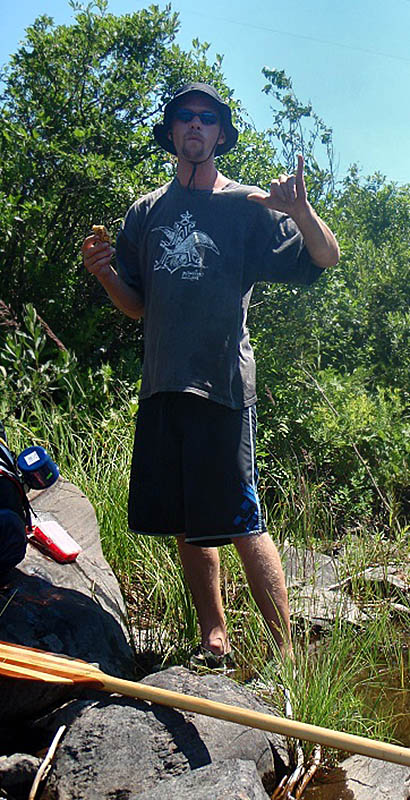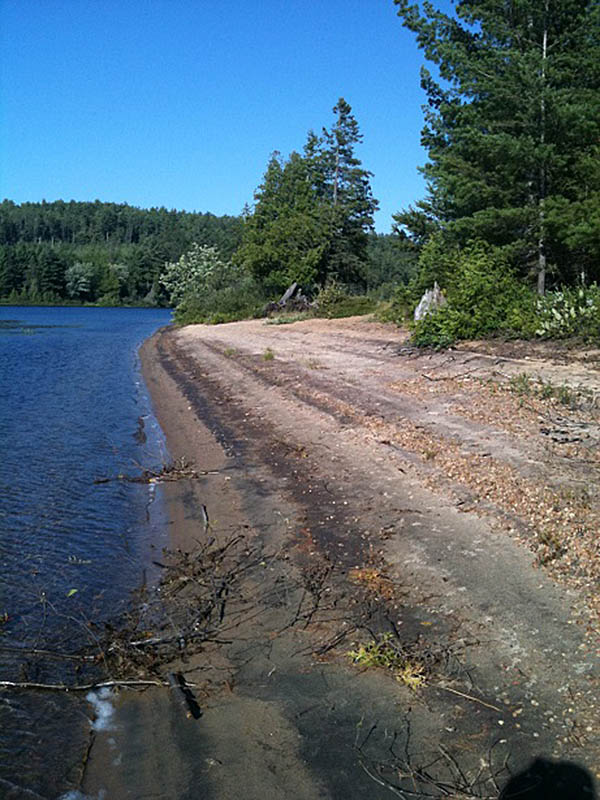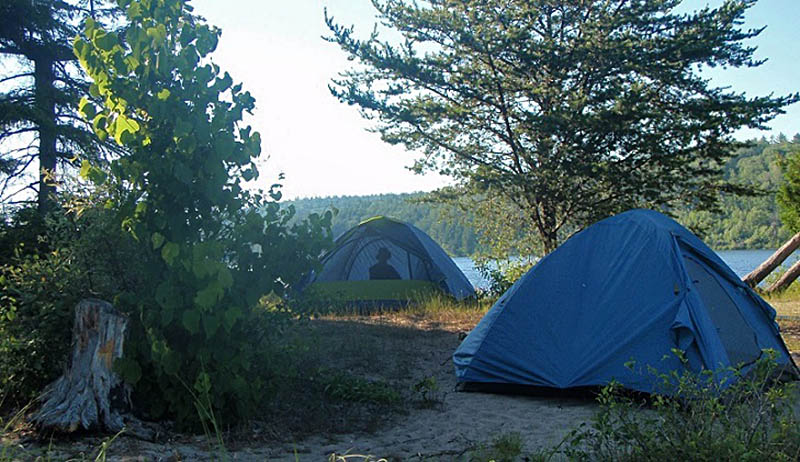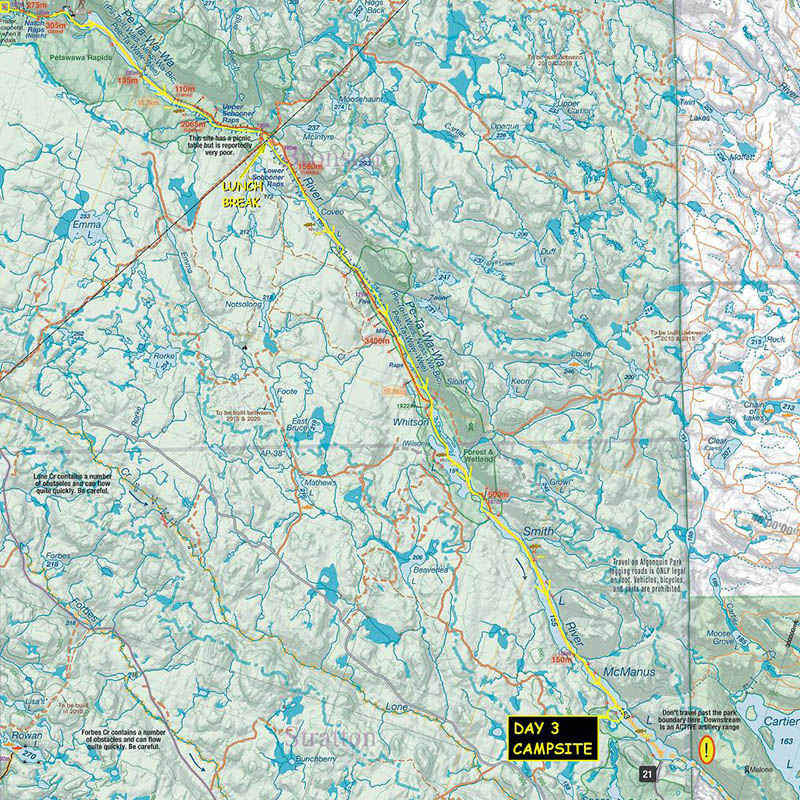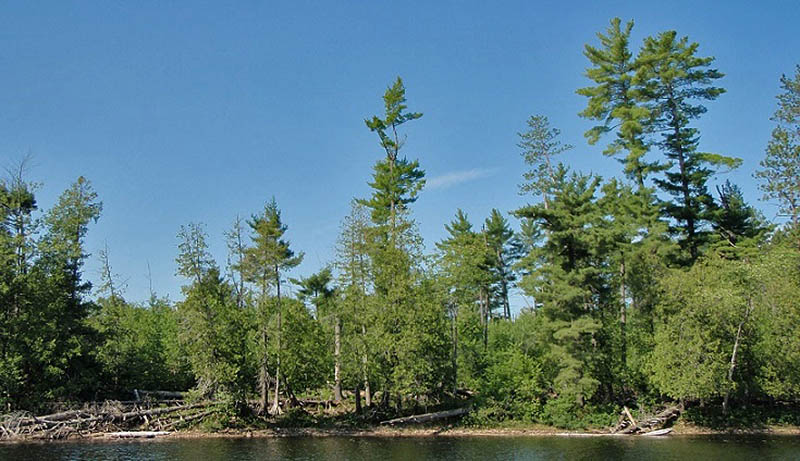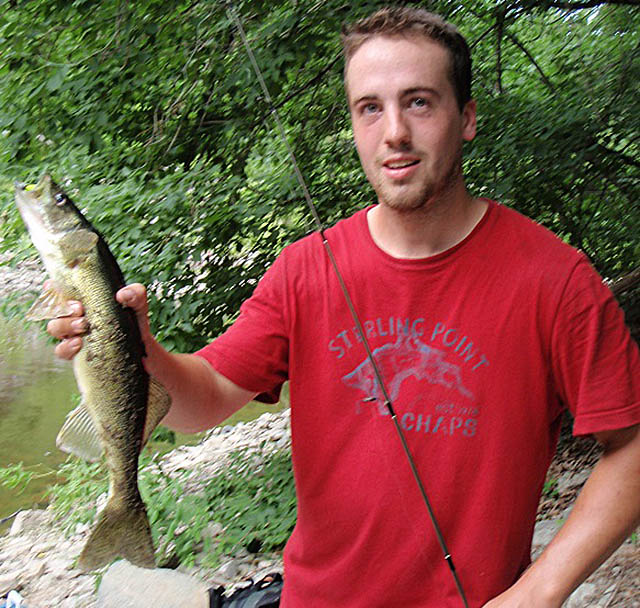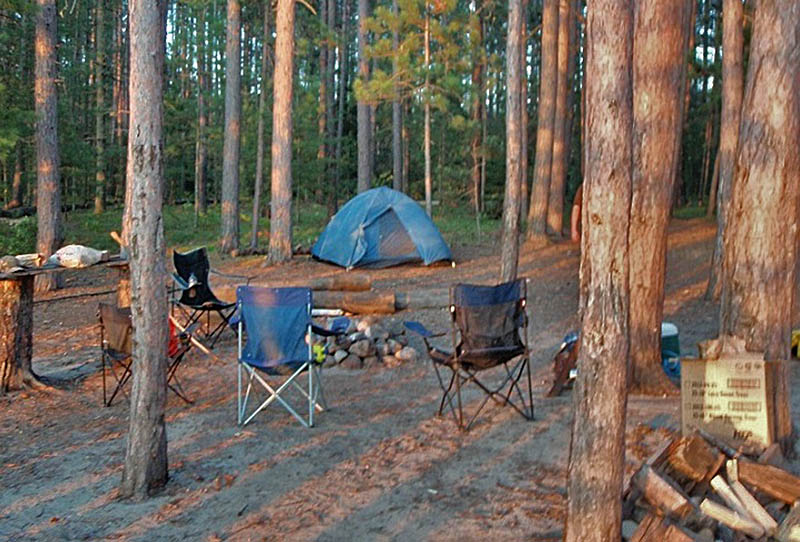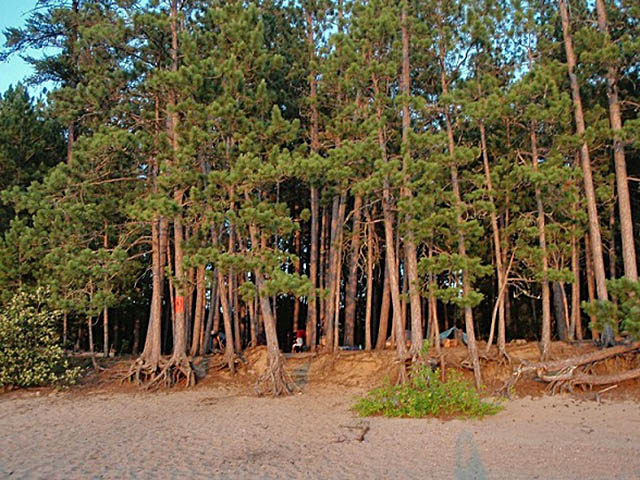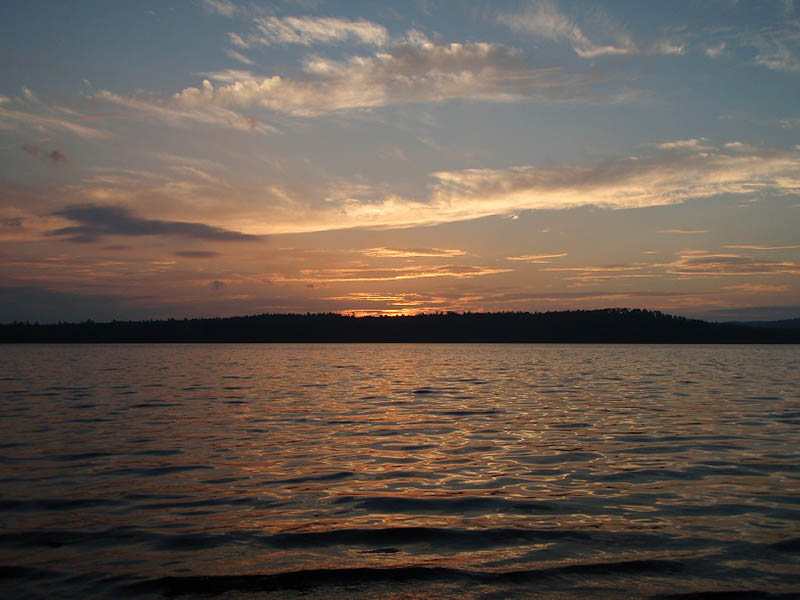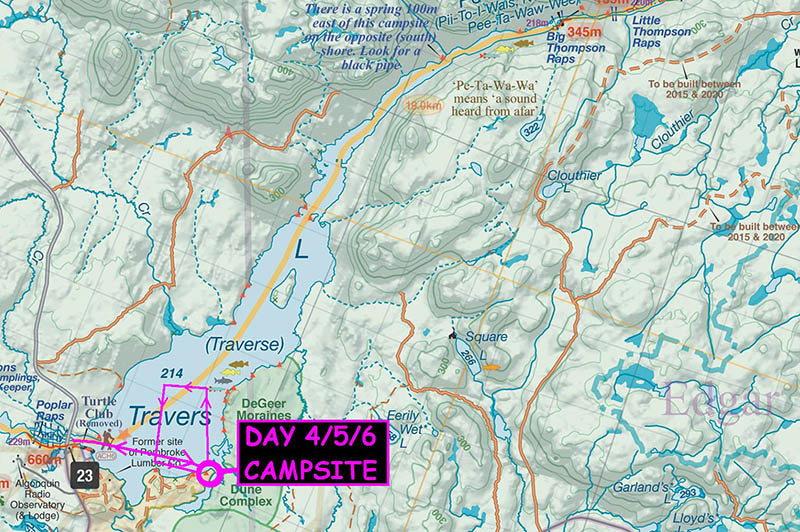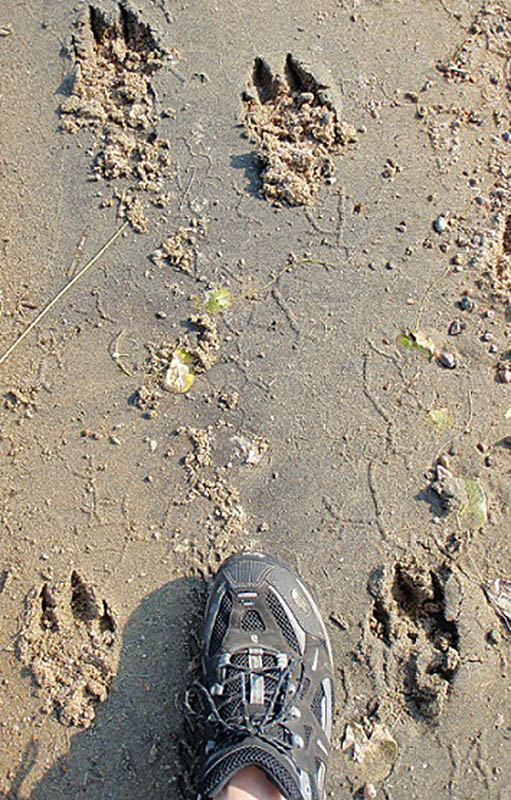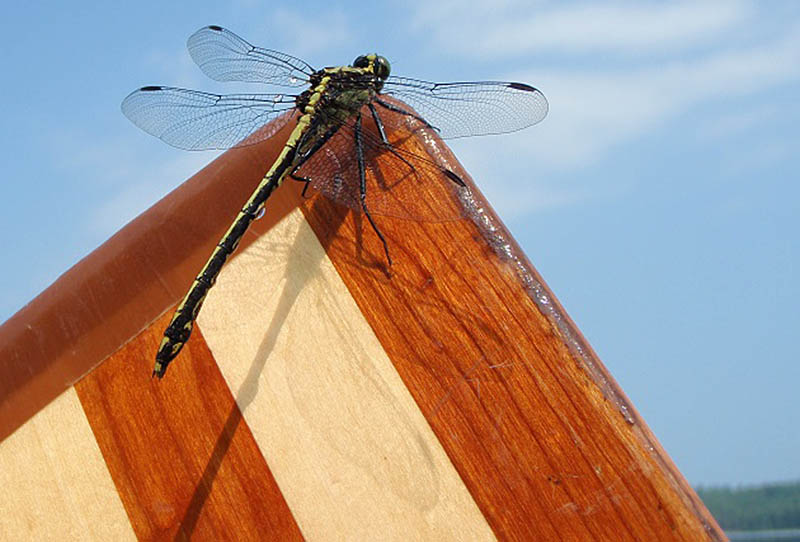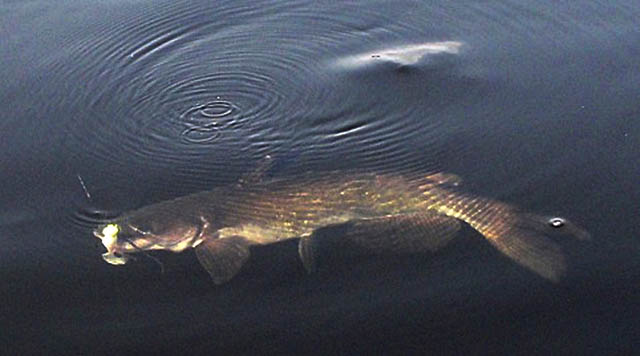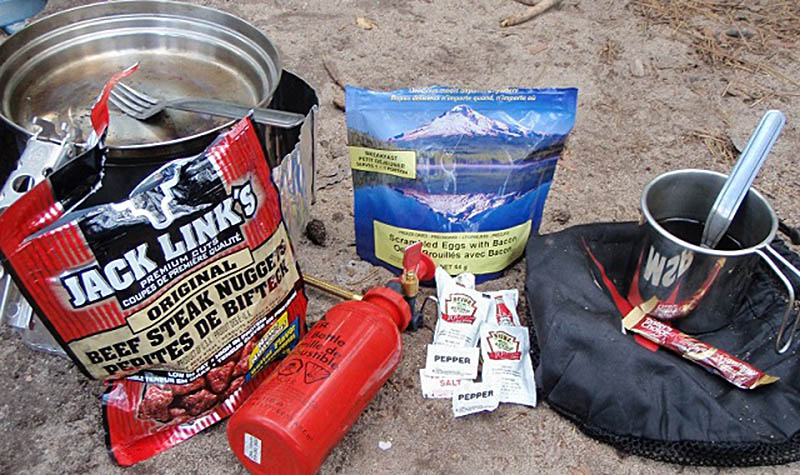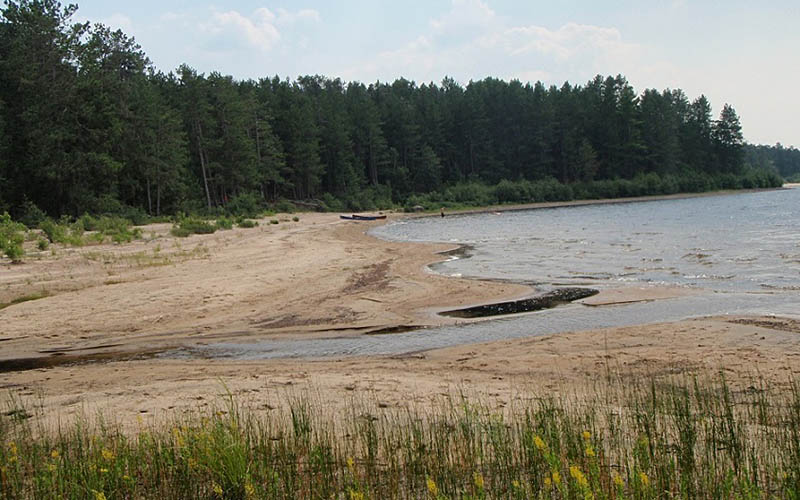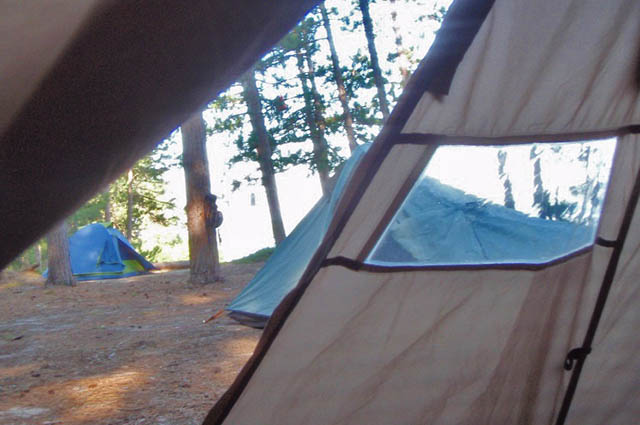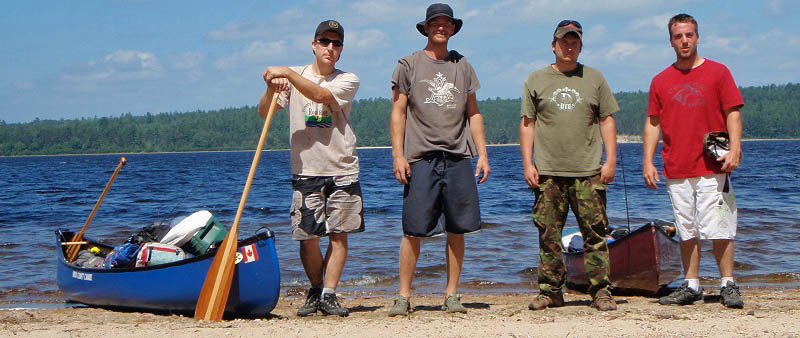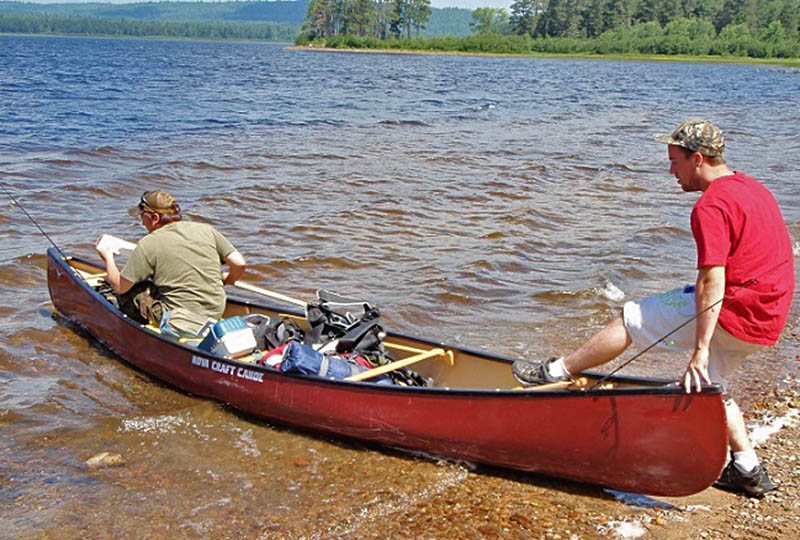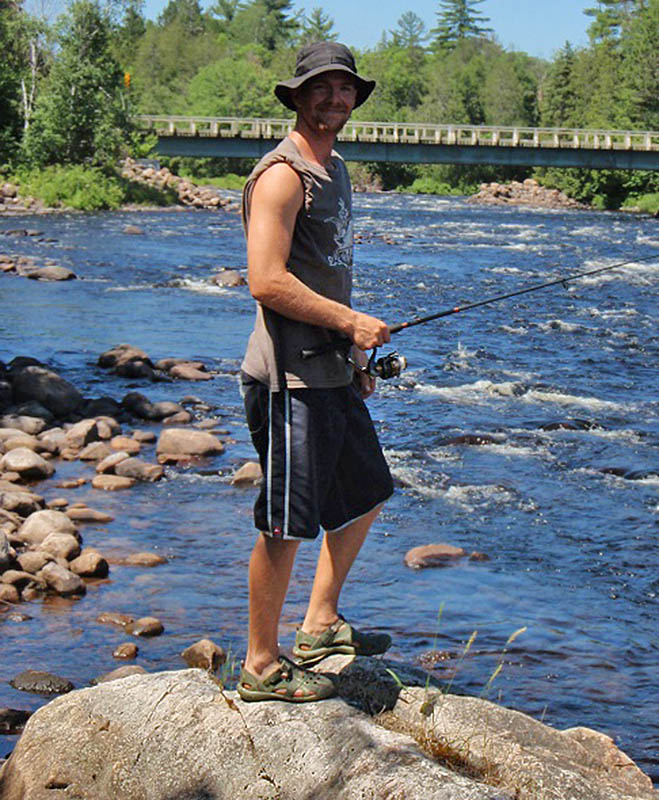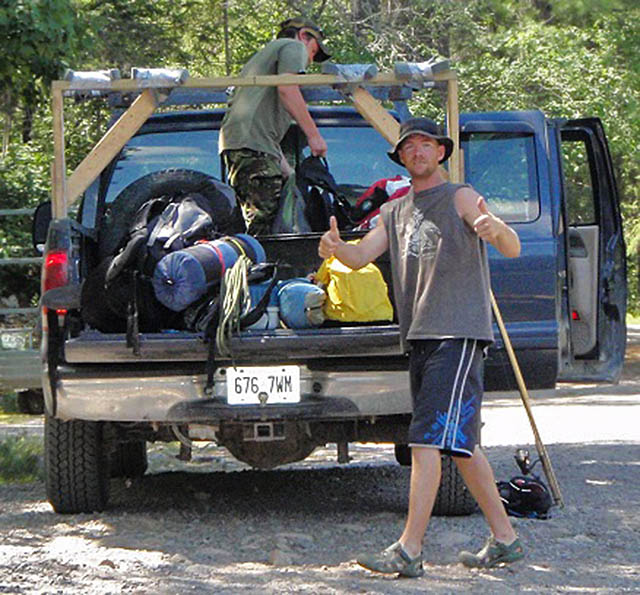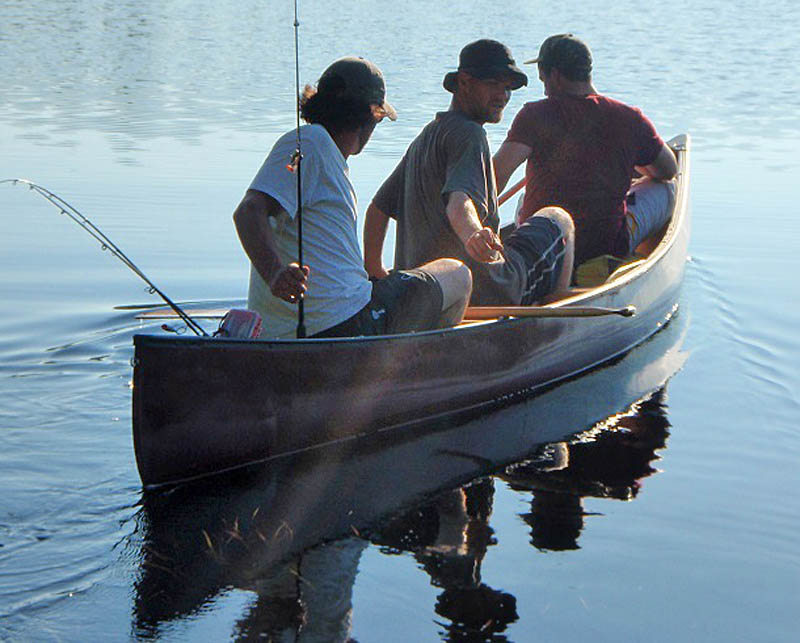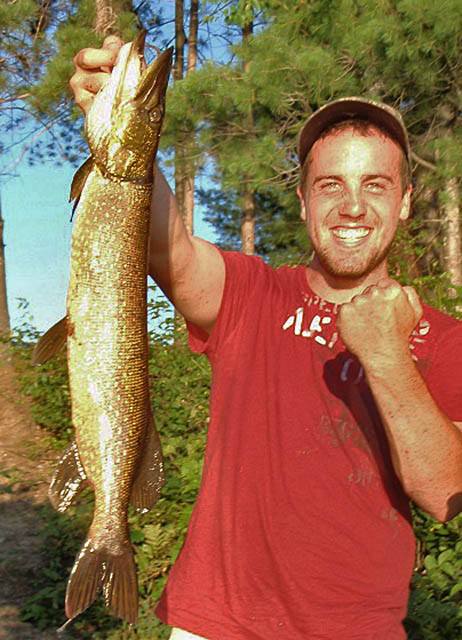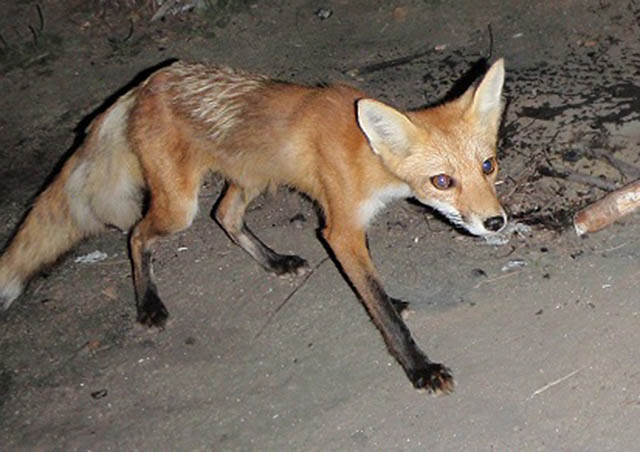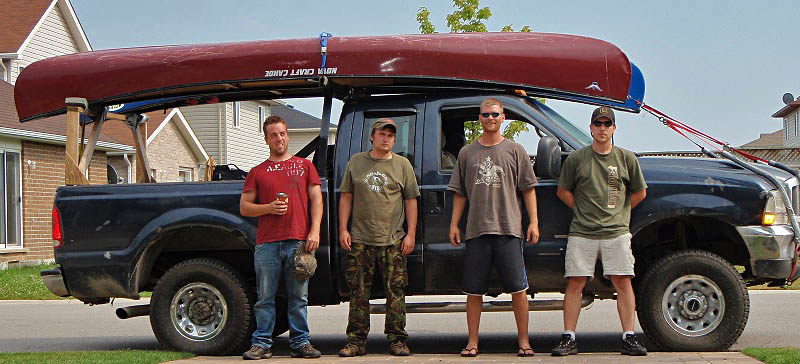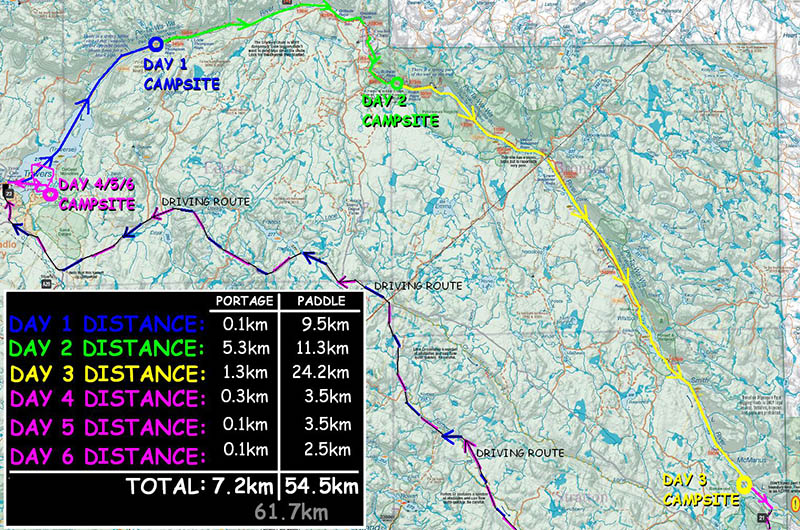Travel Day The night before the official trip began; we drove almost half the distance to Lake Travers Algonquin and spent the night at Cole’s cottage in Sharbot Lake. We figured it would be nice to start the first day of our trip with about half the driving involved. We stayed up pretty late hanging out at the campfire. That night was a very chilly 6°C. DAY 1 July 2nd Weather: Mostly Sunny - Petawawa Weather Station Temperature: max: 27°C (Humidex: 32°C) min: 6°C We started the day with a little exploring and fishing in the area around the cottage. For brunch we ate a big meal of eggs, toast, home-fries and bacon at an old style pub house. We arrived at Lake Travers around 3:30pm and had the canoes loaded and in the water around 4:00pm. Because it was only the late afternoon, the wind was still blowing out of the South West but this worked quite well in our favour, as we were traveling in a North Eastern direction up Lake Travers toward the mouth of the Petawawa River. By 5:45pm we had arrived at the closest campsite to the first portage entering the Petawawa River. Once we got our tents setup we almost immediately started cooking dinner. Most of us had spent a fair amount of time and energy researching high quality, lightweight food options for this year’s trip. It paid off. All the freeze-dried meals on day one were very tasty. After dinner Matt realized that we had forgot to put the parking permit on the dash of the truck. Fortunately for us, a father and son we had talked to at the put-in parking lot happened to be fishing in a motorboat near our campsite. Since we had the parking permit with us, we flagged them down and asked them to place the permit underneath the windshield wiper blade on Matt’s truck. After dinner we did a little bit of fishing in and around the campsite area. The first night in Algonquin would be a very late night. DAY 2 July 3rd Weather: Sunny - Petawawa Weather Station Temperature: max: 32°C (Humidex: 40°C) min: 9°C Day two started out early for some, which offered the opportunity to take in a quiet morning eating breakfast, fishing and relaxing around the campsite. Others slept in and even had a late morning nap in the warm sun. By 1:00pm we had finally packed up camp and were on the water. Just a few hundred meters down river, we were faced with one of many portages that day, Big Thompson Rapids. What a tough way to start the day. To save portaging the canoe, Ryan and I decided to attempt the rapids with an empty canoe, by portaging our gear first and scouting out a good line through the white water on the walk back to the canoe. Judging by the descriptions in the Petawawa River Guide book and the high water marks along the rock walls and trees near the river, the water level at the time of our trip seemed to be about mid-water level. Taking that into account, the first two rapids were listed as Grade 2-3. This would be mine and Ryan’s first ever attempt at any real set of rapids, but we made short work of them in my new Nova Craft (Royalex-plastic/foam) “river” canoe. Cole and Matt wanted to run the rapids listed Grade 2 to 4 during the trip, but decided against it because they were in Ryan’s Nova Craft (fiberglass) “flat-water” canoe and did not want to damage it. This did not stop Cole and Matt from getting in on the action by taking on the role of camera crew while Ryan and I ran rapids. We made our way down several flat long sections of the river and over a few short portages to the beginning of a very dangerous section of the river called Crooked Chute. This section of Rapids started out with a long twisting section of Grade 2 rapids called Grillade Rapids. Considering how long the portage was, we all decided to run the first half of Grillade Rapids with fully loaded canoes. To reduce the risk that we dump our canoes and gear into the river at Crooked Chute (a Grade 4 rapid), we all decided to get out of our canoes just a few hundred meters from the Chute itself. Since Cole and Matt were not wearing swim shorts or water shoes, they decided to walk the portage while Ryan and I swam the canoes close to shore, along the river to the last takeout portage and landed the canoes just 50 meters from the Chute. The decision to swim the canoes was made for several reasons. The first reason was the opportunity to avoid carrying the gear and canoes along a fairly long portage. The second reason, was because at this point in the day it was so hot that Ryan and I wanted a quick dip in the water to cool off anyways, so we figured why not use this opportunity to take the canoes down river with us. (Not to mention by swimming the canoes with no one left in the canoes, as opposed to us paddling the canoes, it would lighten them up by about 350 lbs, so the canoes would sit much higher out of the water and there would be less risk that the canoes could run into partially submerged rocks and flip over.) By 5:00pm we had finished the Crooked Chute portage and paddled by the Crooked Chute cabin located less than 100 meters from the portage put-in. From the water, the outside of the cabin looked in good shape and the site even came with an outhouse. By 6:00pm we had made it to our last portage of the day, Rollway Rapids. For those of you that don’t know, in 1974, Blair Fraser, an experienced white water canoeist, capsized his canoe in this long section of technical class 3-4 rapids and lost his life. As we were novice white water canoeists, we decided to portage our gear and canoes past this section of rapids. The put-in to this portage one of the most rough I have come across and involves some very carefully placed feet to get down the rock trail. By 7:00pm we had arrived at our campsite for night 2. It was the only campsite located between Rollway Rapids and the set of rapids called The Natch Rapids. Some of us were suffering the effects of heat exhaustion and physical exhaustion from having to canoe and portage at the hottest time of the day and needed some time to rest before eating dinner. We ate dinner while marveling at the beauty of Algonquin sitting right out in front of us. Night two in Algonquin would be an early one. DAY 3 July 4th Weather: Sunny - Petawawa Weather Station Temperature: max: 33°C (Humidex: 42°C) min: 17°C Day three would be fairly similar to day two .. wake up, eat, paddle, portage, paddle, portage etc… Today’s weather was also similar to day two .. sunny and very hot! We got on the river by 11:30am and arrived at the first “mountain goat” portage about ten minutes later. The first set rapids and portages for the day was the Natch Rapids. The first set of rapids was a grade 2-3 and with some careful scouting, Ryan and I, in an empty canoe, were able to run them and take on a few inches of water. When I say “a few inches of water”, many may think only a few inches of water is not much, but that much water weighs a lot and makes it quiet difficult to maneuver the canoe in the fast moving water. The second, shorter set of rapids, were rated a grade 3-4. This set of rapids included two, three-foot ledges to contend with in a very narrow, fast moving section of the river. Ryan and I figured the first ledge would give us the most trouble and we figured we could get through the second ledge without any trouble. Well the first ledge gave us hardly any trouble, short of adding a few inches of water to the canoe, but it was the second ledge that got the best of us. Just as the canoe was landing from the drop, the centre of the canoe landed right on a large rock submerged by maybe a foot under the frothy white water. This immediately flipped the canoe over sending Ryan and I into the raging river. Ryan had managed to drop into the water in front of the canoe and not become completely submerged. I on the other hand, had not faired so well. When the canoe flipped I was completely dunked under the water, where I landed right on a submerged rock. When I popped back up to the surface, I realized the canoe was pinned upside down on a partially submerged rock. Because I had been sitting in the back of the canoe, I was now directly upstream of the canoe and headed right for it. I tried to swim out and across the current to get away from the canoe, but that effort was all for nothing. Because of the position I had put my body to prevent my feet from getting stuck in submerged rock crevices, I slammed feet and legs first into the “pinned” canoe. Fortunately, the canoe must have been only partially pinned, because the canoe released its grip from the submerged rock. Then I slammed butt first into the rock and was temporarily pinned against, but managed to get free fairly quickly. When I looked around for Ryan, I found that Ryan had not gone far and had already grabbed a hold of the canoe shortly after it was freed from the rock. It was at this point Ryan and I expected to see Cole and Matt at the portage put-in spot waiting to rescue us with a throw rope, or at least be laughing at our failed attempt at running this set of rapids. Well it turned out they were nowhere to been seen. Now we had the task of swimming the capsized canoe across the powerful current to the rivers edge and save ourselves and the canoe. After emptying the water from the canoe, collecting our gear from the portage put-in and discussing our close encounter with injury or death, we headed off to find Cole and Matt. We found them just entering The Natch cliff area getting in some fishing. Since we were making pretty decent time so far and the scenery was outstanding, we took our time paddling this section of the river. We made our way through a few short swifts (waves and whitewater smaller than a grade 1 rapid) and came upon Upper Scooner Rapids. The rapid was rated a grade 1-2 and the portage was some 2300 meters. Since it was mid-afternoon and very hot, we decided we had had enough of portaging, so with a few rapids under our belts, we ran this set of rapids with all our gear in the canoes. This proved to be a wise idea as we had a fair amount of fun maneuvering around rocks and other obstacles all the way to the hydro lines. It was at this point we decided to stop to eat lunch at an island under the hydro lines. This was a great spot for lunch as it gave us an opportunity to stretch our legs on some large rocks and even jump into the river too cool off. By 2:45pm we decided to move on down the river. Lower Scooner Rapids, which would eventually lead us into Coveo Lake, would be the next set of rapids we ran and they were just as much fun to run as Upper Scooner Rapids. The next set of rapids was called Five Mile Rapids, which is really a misleading name for these rapids, as the portage along the set rapids is only 3,400 meters or 2.1 miles. Since we had some much further to travel to get to our campsite on McManus Lake, we decided to run this set of rapids with our gear in the canoes as well. Again this proved to be a wise idea because the rapids were a nice size to make them worth while to put our novice white water canoeing skills to the test, but safe enough for us to attempt in fully loaded canoes. It was at this point in the trip that the locale flora started to give us the feel of Southern Ontario with the abundance of Silver Maples along the shore line and in the hills of Whitson and Smith Lakes. We did try to do some fishing in these two lakes but did not have much luck. After several short rapids later, we finally arrived at our destination campsite on McManus Lake around 6:00pm. We set up camp quickly and got some dinner into us. The campsite we had chosen was located on a small sandy point on the Southern shore, which made a great location to do some swimming and rinse off from our long hot day on the water. After our swim, we decided to put the canoes out on the lake to do some fishing. It was at this point the mosquitoes came out in full force. This was the first time in the trip that they were really bad and despite the hot weather and we all had to put on long sleeve shirts and pants to keep from getting eaten alive. After fishing most of us had enough of the mosquitoes and retired to our tents for the night. In the middle of the night we were all woken up by an endangered nocturnal bird called the Whippoorwill. Now for anyone who has not heard a Whippoorwill call, it sounds very similar to a car alarm siren. (WHIPPOORWILL - WHIPPOORWILL – WHIPPOORWILL) Needless to say, we now have our own theory on why the Whippoorwill is endangered, as we imagine every creature in the forest (man or beast) would take any opportunity to kill this bird if given the chance. I have an appreciation for all things on earth, but this bird is the most annoying thing I have every come across. I am convinced that this nocturnal bird was created with the sole purpose to test the mental capacity of all creatures. DAY 4 July 5th Weather: Sunny - Petawawa Weather Station Temperature: max: 34°C (Humidex: 46°C) min: 18°C Day four started out early at 6:30am because our campsite had little tree cover and was exposed to the North and East which let the morning sun shine down on our tents. Since the temperature was in the low 20’s overnight, it did not take long for the tents to heat up with the morning sun on them. Despite the morning heat, we all took our time eating breakfast of freshly picked Blueberries from our campsite and whatever else we had packed for our breakfast. We tried some fishing again but, didn’t have much luck. By 9:20am we had the canoes loaded and set out to the parking lot to retrieve Matt’s truck. On our way, we saw first hand how powerful wind can be in Algonquin, as there were thousands of meter wide of trees that had been toppled over by a major wind storm in July 1999. The trip half way down McManus Lake to the parking lot was a short 20 minute paddle. With all the gear and canoes loaded on the truck, we drove into Pembroke to pick up supplies and do some fishing with our good friend Adam. Adam took us to the Muskrat River in downtown Pembroke and several of us caught some nice sized Bass and Pickerel. By late afternoon we decided that we needed to get back into Algonquin as we still had to paddle across Travers Lake, find a campsite and setup camp. By 8:00pm we had managed to find a beautiful large sandy beach campsite on the South shore of the lake. As luck would have it, there was also dry firewood waiting for us. We stayed up late around the campfire enjoying a great warm evening with good friends. DAY 5 July 6th Weather: Sunny - Petawawa Weather Station Temperature: max: 35°C (Humidex: 48°C) min: 20°C I woke up before everyone else on day five at 9:00am and did some exploring on the beach. I found some fresh wolf tracks that seemed to be tracking a deer. This was quite exciting as it is very rare to find fresh wolf tracks. Since no one else was awake yet, I decided to do some early morning fishing by myself. I did hook a very large fish that looked like a pike or muskie, but when I got its head out of the water, it pulled so hard that it snapped my line. I did manage to catch a large catfish. I was only able to get a picture with him on my line in the water since I was alone in the canoe. Despite the fact I didn’t catch many fish, it was so nice and peaceful to start my morning being the only person fishing on a calm lake. By 10:30am Cole, Matt and Ryan had all woken up and we all enjoyed a large breakfast together. Since we didn’t have to pack up our gear on day five, we spent the entire day relaxing around camp and on the beach. It was another hot day, so we mainly were just trying to keep cool by sitting in the shade and having quick dips in the lake. Since there were so many blueberry bushes on this campsite, we had dinner with fresh blueberries. After dinner we went out on the lake to do a few hours of fishing. That evening was a fairly early night as everyone was pretty wore out from the heat all day. It was so warm that night, we needed to sleep with the tent’s rain fly open again just to keep it cool enough inside the tent to be able to sleep comfortably. When we got home and checked the historical data from the Pembroke weather station, we would realize just how hot it had been. DAY 6 July 7th Weather: Sunny - Petawawa Weather Station Temperature: max: 34°C (Humidex: 46°C) min: 18°C On the morning of day six, Ryan and I had planned on going fishing together first thing in the morning. Unfortunately, Ryan was not able to wake me up so he went fishing on his own. By 11:30am we had our gear packed up and loaded in the canoes. It was just a short paddle back to the parking lot and since the day was still fairly young, Ryan and I decided to try some fishing where the Petawawa River fed into Lake Travers. We didn’t have any luck, but it was nice to hang out at this lake once more before leaving. We'd made plans to pick up Adam from Pembroke and spend the night at a free drive-in campsite on Sand Lake, located just East of the park, on Crown land.Once camp was set up, Adam, Cole and Ryan set out in the canoe to do some fishing. They all had some luck at catching a few pike, but Cole managed to land a decent sized 21 inch pike. After the excitement of the pike, we started chopping wood for the fire and played around with Adam’s throwing knives for an hour or so. Once it got dark we all made some dinner and had a few drinks around the fire. Being as we were so close to CFB Petawawa, there was an army helicopter that flew over us a few times just above treetop height both before and after sunset. Later on we set out on a walk and when we returned, we noticed a small fox was at our campsite. He wasn’t very scared of us and he hung out, running in between us as we sat around the fire while cooking more food. That night was a very late last night for us as we didn’t get to sleep until sometime after 2:00am. DAY 7 July 8th Weather: Sunny - Petawawa Weather Station Temperature: max: 36°C (Humidex: 48°C) min: 18°C Day seven had us awake shortly after 6:00am because, for the second time this trip, our campsite was exposed to the North and East which let the morning sun shine down on our tents. This was by far the hottest morning and by the time we had packed up our gear at 7:30am, we were soaked with sweat. We had to drop Adam off in Pembroke, so we spent a little time in town before grabbing a sandwich from Subway and filling the truck up with gas for the long trip home. Fortunately for us, Matt’s truck was air conditioned and the drive home wasn’t too bad. 2010 TRIP CONCLUSIONS 2010’s trip was definitely one to remember. It was the first time any of us had attempted rapids larger than a swift, yet we had all managed to shoot some fairly large rapids with empty and even fully loaded canoes. We did luck-out with the river being mid-level in volume. Many people have noted problems making it past shallow sections of the river in low water and end up having to walk their canoes in the water, or doing portages past these sections. In high water the river can be dangerous, because of fast moving, extremely strong currents and many of the rapids we ran with fully loaded canoes, may have had needed to be done with empty canoes, or portaged past all together. As far as the Petawawa River portion of the trip, we did have some pretty long days in order to keep on schedule, but it wasn’t an impossible feat. If we added another day to the trip, it would have helped spread out the distance travelled and would have made it less strenuous on us. For the relaxation time of our trip, we managed to find a great campsite on Lake Travers that had an outstanding view of sunsets and fairly good shade in the morning allowing the tents to stay relatively cool. The campsite also had a great sandy beach which provided us lots of room to run around and would make a great campsite for a family with kids. Lake Travers does offer some good big-fish opportunities such as muskie, pike, pickeral, catfish, bass and trout. The long drive to access Lake Travers (72km or over an hour from the main highway) does make it a fairly secluded Lake. The only two small downsides that could take away from the “back-country” feel, is that there are small motor boats allowed on this Lake and you can see the large satellite dish from almost anywhere on the Lake. Overall, I would definitely consider a future multi-day camping trip on Lake Travers, as I would like to explore more of the fishing opportunities and local logging history hidden around the Lake Travers area. Bringing high quality, lightweight food was a big bonus. Not only did it taste great, it allowed us a simple clean option for our meals. We simply boiled water, added it to the package, mix the contents and twenty minutes later we could eat. The twenty minute wait wasn’t a big deal as we could just do camp chores while waiting for the food to rehydrate. The cleanup was also easy as the food bags had a Ziploc seal on it which allowed us to pack out our light food packages without creating a mess inside our food bag. The weather more or less cooperated with us this year. Not counting the few drops of rain on the truck’s windshield on the drive into the park, this was the first year that we did not encounter rain, which is very rare for Algonquin. The extreme heat was something we also haven’t had to contend with on an Algonquin trip. We found it very difficult to stay hydrated and cool while being outside all day, but hot, humid days, are better than cool, rainy days.